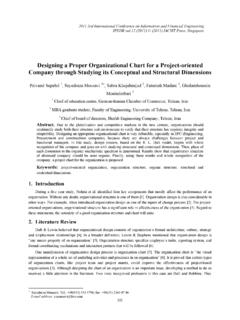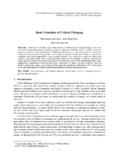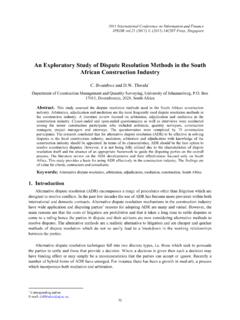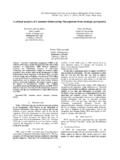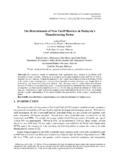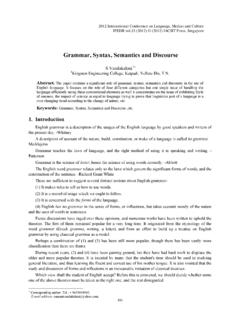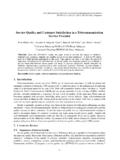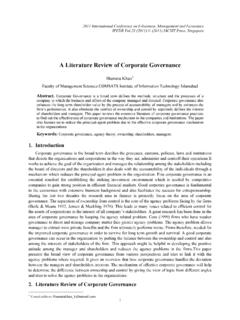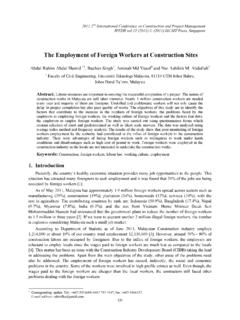Transcription of The provision of counseling services in the secondary ...
1 2012 2nd International Conference on Social Science and Humanity IPEDR (2012) (2012) IACSIT Press, Singapore The provision of counseling services in the secondary schools of Perak state, Malaysia Jin Kuan Kok , Sew Kim Low, Mah Ngee Lee, Phaik Kin Cheah Universiti Tunku Abdul Rahman, Kampar, Malaysia Abstract. Counselling helps to attend to the social emotional needs of the school students to remove obstacles of learning, thus it is an integral part of education. Counselling service in the secondary schools in Malaysia has been established seen 1963 and almost all the National secondary schools in Malaysia has at least one school counsellor. This study aims to identify the perceptions of their role and job scope of the counseling provision in the secondary schools of Perak state, Malaysia.
2 A questionnaire was sent to 235 secondary schools in Perak. Altogether 13 school counsellors were interviewed using semi-structured questions. The findings suggest that the counselling provision is well established as a form of service in the government secondary schools. The guidance programme was found to be centralized, unpopular, and the experience of the counsellors was needs driven, rather than a whole school integrated approach. The perception from the counsellor on how this provision of counselling can be improved to help the school children better cope with the emotional and behavioural problems is captured. A more integrated whole school collaborative approach which draws in all the stake holders of education is proposed.
3 Keywords: school counselling, whole school approach, eco-systemic, secondary school counselling, school counselling model 1. Introduction The counselling services in Malaysian schools gained momentum with the setting up of the Guidance and Counselling section in the Education Planning and Research division in 1963. It was considered as a panacea for social evils such as drug addiction delinquency and indiscipline in school [1]. Hence in Malaysia, counselling is not well received by students, teachers and school communities [2]. Most of the students are involuntarily clients. This unpopularity of counselling services among school students is also further supported by studies conducted by Aminah Hashim [3] and Zulkifli Hamid [4] which found that students were inclined to turn to their friends or family members when they have problems.
4 According to Schmidt [5] a comprehensive counselling and guidance programme should cover the educational, career, personal and social development of the students. Besides, prevention and remedial programmes are also important in helping to prevent social ills in schools. Chai [6] in his studies found that only of students actually utilised the counselling services for emotional or mental problem. This is because students are unwilling to disclose their problems to another person due to their culture and difficulty in expressing their feelings and emotions. However, they are more willingly to seek counselling services for school work or career problems. Counsellors are ranked low as a source of help in personal problems.
5 They will only seek counsellor assistance when their primary support system has failed to effectively solve their problem [2]. This findings were also supported by western researchers like Gysbers and Henderson [7] who proposed a school comprehensive counselling programme to take note of supporting the pupils and the . E-mail: 1. supporting network of the pupils which include all the stake holders of education. The findings also go inline with the work done by Parham & Tinsley [8]. In the United Kingdom, the provision of counselling services has undergone a shift from an individual focus to a community and multidisciplinary focus [9]. The same scenario happened in the United State whereby the provision of school counselling services has changed from focusing on vocational emphasis to mental heath, and later to a comprehensive guidance programme approach to work collaboratively with the community resource [10; 7] Myrick [11] advocates that school counsellors should consult the adults, especially the significant adults in the students' lives, for the benefits of the school children.
6 This community based that take note of the wider environment of the children actually has a theorectical framework originated by Bronfenbrenner [12; 13]. Based on this foundation, Myrick [11] proposed a comprehensive developmental model of school counselling to include the developmental, preventive and the remedial aspect of school counselling. The school counselling service in Malaysia secondary school system appears to be well established and it has been implemented that every secondary school is funded with a full time school counsellor. However, there was a lack of research into the role and function of those services , especially from the perspective of the school counsellors on how they experience these roles, and how they think the counselling services could be better improved to benefit the school children.
7 2. Methodology This research sought to examine the school counsellors' perceptions of their role and job in the secondary schools system in Perak, Malaysia to further explore the development of a comprehensive school counselling model that would benefit the school community. Two focus groups comprised school counsellors, one from urban city and the other from rural part of the state, were held prior to the research. Themes emerged from the focus groups helped to design the questionnaire which contained both structured and open-ended questions. A large scale survey questionnaire was sent out to 235 secondary schools in Perak state. Perak state was chosen as all the researchers work as academic staff in one of the universities in Perak, and the research funding of this studies has a strong educational interest to provide intellectual services in the state.
8 Initial response from the posted questionnaire was not sufficient for the research to be carried out, only 15 respondents replied. It was decided to contact the randomly chosen schools individually by telephone calls and personal visitations. The choice criteria followed the proportions of school size. Equal opportunity was given to different school size (Schools with more than 1000 students were considered big size; schools with student enrollment of 500 to 1000 were considered medium size; schools with less than 500 students were considered small size). Eventually, 83 schools responded and 13 school counsellors were interviewed. Interviews with volunteered school counsellors were carried out by a team of 4 researchers.
9 Semi- structured questions were prepared to provide a general guidelines and structure for the interview sessions. The whole process of research followed the general ethic and guidelines of the research community. Permission for conducting the research was obtained from the Ministry of Education. Respondents were informed of their right and were encouraged to share their experience and thoughts. They were also assured that materials made public would not reveal any personal information or the name of their school. The structured question data were entered and analysed by SPSS to give simple statistic figures of participating schools. While the open-ended questions were analysed via Nvivo to identify emerging themes and patterns.
10 Interview sessions were transcribed and all the verbatim transcripts were clustered into themes via the node coding using Nvivo. The thematic analysis process followed the principles proposed by Miles and Huberman [14]. Frequency and percentage of school in the number of counsellor Seven out of 82 schools have only 1 counsellor. While 35( ) schools have 2 counsellors; 31( ). schools have 3 counsellors; 7 ( ) schools have 4 counsellors; and only 1 ( ) school have 6. counsellors 2. Demography of the school counsellors The gender and the demography of school counsellors are shown in the tables below. Table1: Gender of counsellors Table 2: Frequency and percentage of counsellor in different age-group Gender Frequency Percentage (%) Age group of counselor Frequency Percentage (%).
